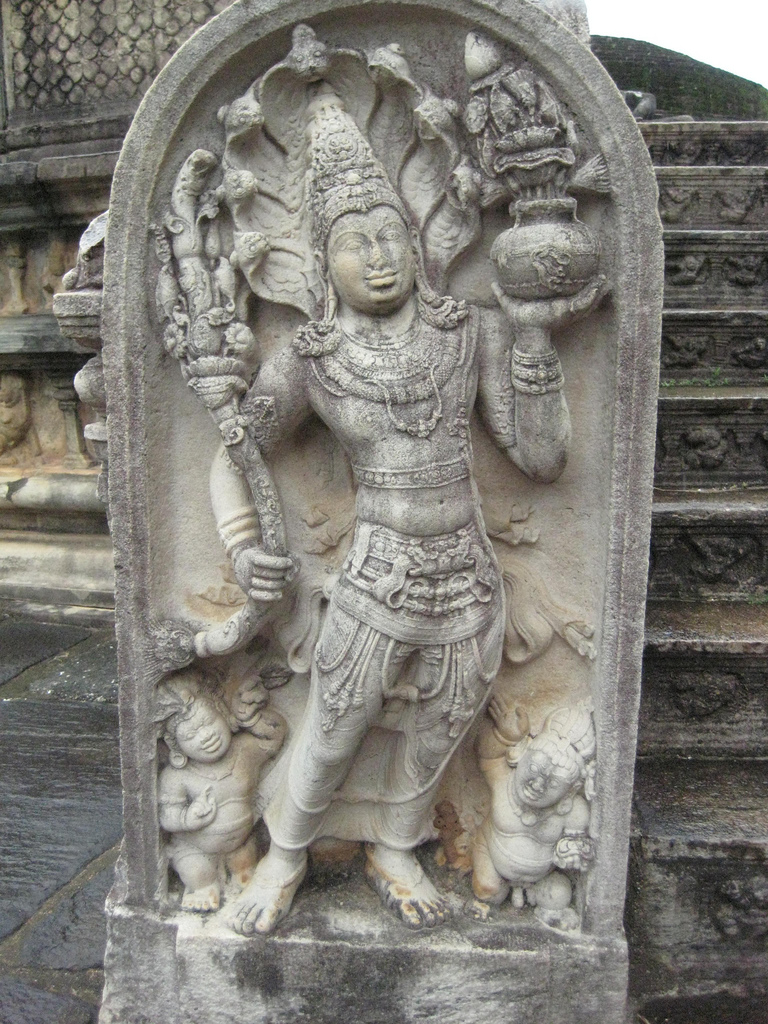Muragala on:
[Wikipedia]
[Google]
[Amazon]
Muragala or muru gal, also known as a guardstone, are a unique feature of the Sinhalese architecture of ancient Sri Lanka. The muragala is a set of twin oblong slabs of stone, with a rounded top, located at the foot of the flight of steps, leading to a place of worship, situated on a higher elevation.
 The evolution of the muragala is closely linked to the evolution of the Sandakada pahana (or moonstone).
The evolution of the muragala is closely linked to the evolution of the Sandakada pahana (or moonstone).  More recently archeologists consider that muragala merely served as a decorative feature, rather than a structural purpose.
The earliest muragala date back to the early period of the
More recently archeologists consider that muragala merely served as a decorative feature, rather than a structural purpose.
The earliest muragala date back to the early period of the
 The evolution of the muragala is closely linked to the evolution of the Sandakada pahana (or moonstone).
The evolution of the muragala is closely linked to the evolution of the Sandakada pahana (or moonstone). Charles Godakumbura
Doctor Charles Edmund Godakumbura (5 December 1907 – 7 February 1977) was the Commissioner of Archaeology in Ceylon (Sri Lanka) from 1956 to 1967.
Early life
He was born on 5 December 1907 in Chilaw in the North Western province of the cou ...
, the Commissioner of Archaeology in Ceylon from 1956 to 1967, described the evolution of the muragala from its origins as a painted wooden plank or a stone terminal slab, serving as a stop wedge at the lower end of a slanting rail or balustrade
A baluster is an upright support, often a vertical moulded shaft, square, or lathe-turned form found in stairways, parapets, and other architectural features. In furniture construction it is known as a spindle. Common materials used in its con ...
(korawakgala
Korawakgala, or koravakgal ( si, කොරවක්ගල) (wingstones), are stone balustrades, which are located on either side of the stairs/steps leading to the entrance or door of a religious building or structure. They form one of three dist ...
) through to its final form as an elaborate carved stone. He distinguished five phases in its evolution:
*firstly, pieces of valuable wood;
*secondly, plain stone slabs;
*thirdly, stones with an incised pūrṇaghaṭa (vessels of abundance) motif, subsequently rendered in low or high relief;
*fourthly, stones where the carvings are replaced by figures of Bahirava or dwarfs, one on each stone, usually depicting Śańkha and Padma, attendants of Kuvera (God of Wealth), or bhūtas (powerful protective ghosts/spirits);
*final phase, which is the most common in the more important monastic buildings at Anuradhapura
Anuradhapura ( si, අනුරාධපුරය, translit=Anurādhapuraya; ta, அனுராதபுரம், translit=Aṉurātapuram) is a major city located in north central plain of Sri Lanka. It is the capital city of North Central ...
, features elaborately carved anthropomorphic
Anthropomorphism is the attribution of human traits, emotions, or intentions to non-human entities. It is considered to be an innate tendency of human psychology.
Personification is the related attribution of human form and characteristics t ...
nāgarājas (snake gods), typical of the latter stages of the Anuradhapura period
The Anuradhapura period was a period in the history of Sri Lanka of the Anuradhapura Kingdom from 377 BCE to 1017 CE. The period begins when Pandukabhaya, King of Upatissa Nuwara moved the administration to Anuradhapura, becoming the kingdom's ...
and the subsequent Polonnaruwa period
The Polonnaruwa period was a period in the history of Sri Lanka from 1017, after the Chola conquest of Anuradhapura and when the center of administration was moved to Polonnaruwa, to the end of the Kingdom of Polonnaruwa in 1232.
The Kingdom of ...
.
 More recently archeologists consider that muragala merely served as a decorative feature, rather than a structural purpose.
The earliest muragala date back to the early period of the
More recently archeologists consider that muragala merely served as a decorative feature, rather than a structural purpose.
The earliest muragala date back to the early period of the Anuradhapura Kingdom
The Anuradhapura Kingdom (Sinhala language, Sinhala: , translit: Anurādhapura Rājadhāniya, Tamil language, Tamil: ), named for Anuradhapura, its capital city, was the first established monarchy, kingdom in ancient Sri Lanka related to the ...
(approximately 1st century A.D). Over time, the architects switched to the use of stone, as it was a more enduring material. The next stage in the evolution of the guard stones was the inclusion of carvings, however it has been difficult for archeologists to determine exactly when these changes began to take place. During the middle period (2nd century A.D. – 6th century A.D.) and the latter period (7th century A.D. – 11th century A.D.) of the Anuradhapura Kingdom, stone workers began to carve the image of a dwarves (Śańkha and Padma) on the muragala. It was during latter stages of the Anuradhapura Kingdom, that muragala with the images of Nāgarājas were carved. This however was not strictly a consecutive evolution but a succession of overlapping developments, with the most evolved pūrṇaghaṭa motifs not necessarily pre-dating the earliest Nāgarājas carvings.
පොළොන්නරුව
*Korawakgala
Korawakgala, or koravakgal ( si, කොරවක්ගල) (wingstones), are stone balustrades, which are located on either side of the stairs/steps leading to the entrance or door of a religious building or structure. They form one of three dist ...
* Sandakada pahana
References
External links
* {{Sri Lankan Architecture Architecture in Sri Lanka Archaeology of Sri Lanka Buddhist architecture